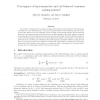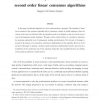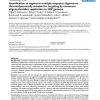3356 search results - page 14 / 672 » Determining Consensus Numbers |
CORR
2011
Springer
13 years 2 months ago
2011
Springer
We consider continuous-time consensus seeking systems whose time-dependent interactions are cut-balanced, in the following sense: if a group of agents influences the remaining on...
CDC
2010
IEEE
13 years 2 months ago
2010
IEEE
In this paper a distributed algorithm for clock synchronization is proposed. This algorithm is based on an extension of the consensus algorithm able to synchronize a family of dou...
GROUP
2005
ACM
14 years 1 months ago
2005
ACM
We introduce the use of negative preferences to produce solutions that are acceptable to a group of users. Using negative preference profiling, a system determines which solution...
BMCBI
2004
13 years 7 months ago
2004
Background: Computer programs for the generation of multiple sequence alignments such as "Clustal W" allow detection of regions that are most conserved among many sequen...
SPAA
2009
ACM
14 years 2 months ago
2009
ACM
We consider bit communication complexity of binary consensus in synchronous message passing systems with processes prone to crashes. A distributed algorithm is locally scalable wh...



